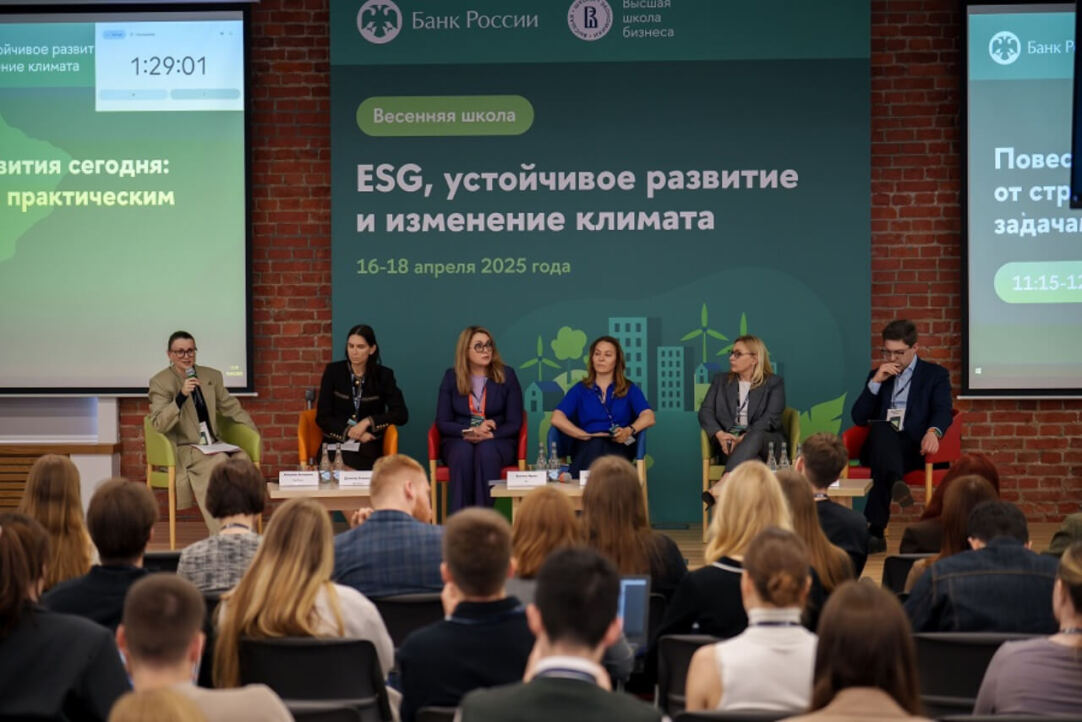From theory to practice: highlights from the Spring ESG School by the Bank of Russia and HSE University

About the School and its participants
The Spring ESG School is a three-day, in-person intensive program. Students took a deep dive into sustainability and climate change, worked through ESG data cases, and explored international standards. At the end of the program, participants received official certificates.
This was the second ESG School co-organized by the Bank of Russia and HSE GSB for university students. (You can learn more about the Fall 2022 ESG School in a report by the Bank of Russia’s Departmental Chair at HSE.)

Andrey Afonin
Director, the Bank of Russia University
We created the ESG School to provide students with practical knowledge they can apply in both their daily lives and professional careers. Our goal is to help them contribute to environmental preservation and foster positive change in the economy and society.
Spring 2025 Cohort: selection and scope
This year, the organizers received over 400 applications from students across Russia. The competitive selection process included three stages: completing the Bank of Russia’s online course “ESG, Sustainable Development, and Climate Change” and earning a certificate, writing an essay, and submitting a resume. A total of 77 students were selected, representing diverse fields — from economics and finance to ecology and law. Participants came from 29 leading universities across Moscow and the Moscow Region, St. Petersburg, Astrakhan, Syktyvkar, Krasnodar, Tomsk, Kazan, and Krasnoyarsk.

Anna Veselova
Director, Center for Corporate Sustainability Management, HSE GSB
In a world facing rapid change and global challenges, we at HSE GSB see a vital need to prepare future leaders who understand and apply sustainability principles in practice. The ESG School, in collaboration with the Bank of Russia, offers students a unique chance to deepen their knowledge, build valuable connections, and get ready to lead the transformation toward more responsible and sustainable business practices. These graduates will be at the forefront of ESG implementation in Russia, helping the business sector not only adapt but thrive in the global sustainability agenda.
A practice-oriented program structure
The ESG School was designed around the principle “from theory to practice” and included:
-
Expert talks by specialists from various departments of the Bank of Russia (Financial Stability, Corporate Affairs, Financial Market Infrastructure, Banking Regulation and Analytics), as well as from over 40 government and corporate entities, including the Russian Ministry of Foreign Affairs, Ministry of Economic Development, Ministry of Energy, VEB.RF, DOM.RF, the Moscow Government, Rosatom, Sber, Gazprombank, Rosselkhozbank, Moscow Exchange, SIBUR, Nornickel, Polyus, Metalloinvest, Severstal, RUSAL, and others.
-
A hands-on workshop on climate risk assessment
-
Group project presentations and open discussions on ESG data visualization
-
Career consulting and interactive sessions from the Bank of Russia's HR team
Participants discussed a wide range of issues — from sustainable finance, ESG disclosure, and international cooperation to how financial and non-financial institutions are addressing climate and biodiversity risks. Additional reflections from students can be found in a report by the Master’s program Low-Carbon Development Management.

Maxim Morozov
Deputy Director, Financial Stability Department, Bank of Russia
During the ESG School, we covered numerous current topics — from global climate cooperation and nature-related risks to creating ESG dashboards. Students not only gained theoretical knowledge but also had the chance to ask questions, analyze real-world cases, and use tools to assess climate risks and the quality of ESG disclosures by leading Russian companies.
Final projects and impact
A key component of the school was a team project: building ESG dashboards based on the non-financial reporting of Russian companies. The goal wasn’t just to teach data visualization, but also to critically assess companies’ strengths and weaknesses in ESG performance.
Participants examined 32 ESG indicators across public disclosures and presented their analysis in dashboard format. They evaluated transparency, readiness to disclose potentially mandatory indicators, and offered recommendations — with company representatives present at the presentations. The dashboard task served as a real-world simulation of work done by ESG analysts.
Twenty-five participants received diplomas for outstanding project presentations and overall performance in the program.

Elizaveta Danilova
Director, Financial Stability Department, Bank of Russia
This is our second time hosting the ESG School, and we’re thrilled to see students’ continued enthusiasm. The school has become a platform for learning, dialogue, networking, and hands-on skill development in sustainable development. There’s growing demand — even among early-career professionals — for open dialogue between regulators, financial, and non-financial companies. These skills will give students a competitive edge in today’s job market, as ESG expertise is increasingly valued across industries. We’re confident that the graduates of this program will contribute meaningfully to advancing sustainability in Russia.

Ekaterina Abasheeva
Director, Corporate Affairs Department, Bank of Russia
Sustainability is highly relevant to Russia, given the carbon-intensive nature of our economy, and also presents an opportunity for technological leadership. But it’s crucial to align ESG efforts with national priorities: sustainable development should not come at the expense of economic growth or citizens' well-being. ESG is one of the few global topics that enables dialogue with international partners. Participating in the ESG School is not only about deepening your knowledge — it’s also a chance to get inspired, join discussions, and share your vision of the future.
